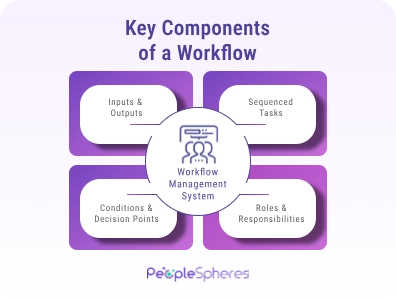
11 min
What You Need to Know Before Investing In a Workflow Management System
Written by
Wish you could get your work done faster? Do things like back-and-forth emails and searching for attachments slow you down? Not sure what the next steps of a task are? A workflow management system might be the answer you are looking for.
These are common problems in every organization. In a 2021 report by Zapier, 94% of workers indicated that they perform repetitive, time-consuming tasks including data entry and document management.
But fortunately, automation can help speed up and even eliminate these tasks. A tool like a workflow management system can help your organization automate business processes and work more efficiently.
Ready to make your business operations more productive? And eliminate tedious tasks altogether? This article will discuss what you should know about workflow management systems and the essential criteria to look for when deciding on a workflow management system to automate your processes.
Related articles:
5 Workflows to Simplify Your Life as an HR Professional
HR Workflow: Your Ultimate Solution for Workforce Management
What is Workflow Management?
Workflow management involves designing and improving the paths for data to complete allotted tasks in a specific time. It involves using workflow software to identify redundant tasks, create an efficient process, and brainstorm areas for improvement.
Key Components of a Workflow

1. Inputs & Outputs
Inputs are the starting point of any workflow. This can be anything from data, to documents to requests. For example, it can be an employee’s time-off request. Identifying the inputs means defining what is needed to begin the process.
Similarly, the outputs are the ultimate goal of a workflow. What documents or deliverables are needed to complete the workflow? Establishing the standards that these outputs must meet is equally as important as defining what they are.
2. Sequenced Tasks
Tasks are a set of individual actions or activities in the workflow that need to be completed in a sequential or parallel manner.
These tasks can vary in complexity. Some actions can be fully automated with workflow systems, while others will require human intervention. It’s also important to define what needs to be done for each task and any dependencies between them.
3. Conditions and Decision Points
Conditions or decision points are the laws of the workflow software. They determine when one step is completed the next one begins, based on a set of criteria. Make sure to define the actions associated with each possible outcome of these decision points.
Conditions are most suitable for approval workflows, for example, where specific steps can be skipped if certain criteria are met.
4. Roles and Responsibilities
Workflows also define the people or roles who are responsible for carrying out specific tasks. They can be assigned specific steps or be responsible for the entire workflow. Clearly defining roles ensures accountability and efficiency, by avoiding confusion on who does what. For enhanced workflow organization and clear visualization of team structures, it can be extremely beneficial to utilize an organizational chart creator to map reporting lines and responsibilities within your system.
Thanks to automation, there are cases where no action is needed from the responsible parties. Instead, they only step in when certain conditions are met or issues come up.
Why is a Workflow Management System needed in your company?
Poorly organized tasks arise in piles of files and folders containing receipts, invoices, documents, forms, and leave requests. Even the largest organizations may end up with unorganized documents and unstructured tasks if they fail to put an effective workflow management system in place.
Industries need an integrated workflow management system to manage the workflows across their business applications, increase productivity, improve communication and more. The Zapier report indicates that automation helps 65% of knowledge workers become more productive and 63% said it helps them fight burnout.
Benefits of a Workflow Management System
Aside from the productivity and time savings an efficient workflow management system (WMS) can bring to your business, other benefits include:
More Insight into Business Processes
Not only does a WMS allow you to automate and streamline business processes, it also provides a clear, visual representation of the entire workflow. This can help stakeholders to understand how tasks are related and how certain data flows throughout the organization.
More importantly, being able to track the progress of tasks and collect data allows you to identify bottlenecks and inefficiencies in your processes. A good WMS can generate performance metrics so you can make data-driven decisions for improving your processes.
Identifying Redundancies
Various forms of unnecessary and repetitive tasks happen daily, but once you map out your processes, you can easily eliminate redundancies.
Identifying and eliminating unimportant activities has a lot of benefits. For example, instead of wasting time on irrelevant tasks, your staff will be paying attention to what is essential and leveraging what adds value to the business.
Increase Accountability
By mapping out your workflow, everyone knows what tasks need to be done when and by who. Therefore, there are fewer questions since everyone understands what workload and responsibility belongs to whom.
A workflow management system will typically maintain detailed audit trails that serve as a record of who performed which actions. This promotes accountability and transparency.
In addition, automated notifications and reminders can be set up in a WMS to make sure that tasks are not overlooked or delayed. This further increases accountability.
Improved Communication
A workflow management system has the ability to centralize information related to any process. This centralization helps stakeholders access up-to-date information and reduces the likelihood of miscommunication. In fact, real-time visibility enables better communication and quicker responses to change.
Some platforms include collaboration features such as document sharing and discussion threads that allow team members to collaborate within the system.
7 Essential Features of a Workflow Management System
1. No-Code Workflow Designer
A good workflow management system has an easy and intuitive interface but can build complex processes. It can involve using a no-code functionality such as drag-and-drop tools to create your workflows. Bootstrap templates can enhance this process by providing pre-designed, responsive layouts for displaying workflow statuses, task progress, and team management in a user-friendly format.
This feature can be used to define the series of tasks that need to be completed. For example, when a new employee is hired, a WMS can trigger tasks such as automatically creating user accounts, assigning training modules and scheduling orientation sessions.
2. Integration with HR Software
Integrate your WMS with HR software to create cross-application workflows. HR functions need to be able to work together to work efficiently. For instance, a software such as an applicant tracking system (ATS) can seamlessly transfer candidate information and automate the onboarding process, including setting up an account in all your different business tools. Integrating these systems effectively can be complex, making managed application services a valuable option for businesses seeking expert support.
If your HR system is difficult to set up and does not run smoothly with other tools, it is already outdated and unsustainable for your business needs and the future growth of your company.
3. Task Assignment and Tracking
Your workflow software should allow you to assign specific tasks to team members. This can include things like conducting job interviews, reviewing resumes. Your WMS should track the process of each task to ensure that no step in the process is missed.
4. Reporting and Analytics Tools
Along with tracking progress on specific tasks, you can also analyze the efficiency of your HR processes with a WMS. A solid metric-based reporting tool in your workforce management system will help you identify where to put your attention and analyze where your bottlenecks are.
You can generate reports on HR metrics like time-to-fill job vacancies or training completion rates to see whether changes need to be made to your processes.
5. Notifications and Alerts
Notifications can be useful, especially for complex processes that have several condition and stakeholders involved. An efficient workflow management system will send alerts via email or phone to notify you of pending approvals, actions, and more. Users should also be allowed to customize the types of notifications and messaging they receive.
You can use these notifications to remind you of things like upcoming performance reviews, benefits open enrollment periods or compliance training deadlines.
6. Role-based Access Control
There is a balance that needs to be established between transparency and data privacy. In fact, many workflows have vital information that shouldn’t be shared with everyone in the process.
Hence, a good workflow management system is service oriented and should allow you to customize what each of the users can see. However, making these simple changes shouldn’t break the workflow or affect the ability to access historical requests.
7. Form and Document Management
Your workflow software should allow you to store and manage documents that are considered inputs and outputs of your workflows. This ensures easy access and compliance with document and data retention policies. A robust resume builder can help streamline the creation and formatting of professional job application documents that will be processed through your workflow system.
For example, HR documents such as resumes, employment contracts, performance review should be stored in a centralized repository. Furthermore, some platforms allow you to generate such documents directly.
Questions to Ask Before Deciding on the Workflow Management System You Want
1. What are your business requirements for your workflows?
It would be best to have comprehensive workflow solutions for essential processes across the organization. You might also need something less tasking that allows the team leaders to make decisions independently, so they have a certain amount of power over the entire process flow.
2. What are your non-negotiable features for workflow management?
Most workflow software are the same at the basic stage, however, their different features can help you pay attention to the best options available. Ask vital questions like:
- Is the workflow builder simple enough for my system administrator to use?
- How complex does my reporting need to be?
- Is there a specific type of field that I can’t work without?
3. How many users will you have in the workflow?
Firstly, ask yourself if the software will be used by the entire company or just a few people. Do you want to involve external users in the workflow engine? Check with various merchants to see what their limits are for their various user types. This is also a good point to consider in order to estimate software costs and forecast the ROI of your investment.
4. How quickly do you plan to use the software?
If you want workflow software that can automate a single process, choose one right away. If you want something that will automate a lot of processes in the company by making your workflow system more organized, then take your time. Advanced workflow software sometimes take months to create, train, develop the workflows, and make them work. Other simpler tools, however, require little or no training and can be used on the first day of purchase. Consider looking for free trial options in order to get an idea of how quickly you can deploy the software within your organization.
5. How much assistance do you need?
Once you have the integrated workflow, how much assistance do you need? The demand for software tools has increased a lot in the past few years, and the internal IT teams cannot be experts in each one. Hence, the vendor you choose to use must provide functional and efficient support. These come in various forms like video guides, comprehensive documentation, and instant chat support. During the trial session of the workflow solution, try to interact with the support team to test its efficiency and responsiveness. To ensure seamless adaptability to various devices and screen sizes, explore responsive web design testing tools.
Conclusion
Having a sound workflow management system is very important if you wish to remain productive and stay at the top of today’s tech-driven business environment. Hence, it is crucial to make the right decision because this choice will stay with you for a while. Don’t ever settle for anything less than best-in-class. Also, keep the above questions and features in mind as you investigate your options.

 (1)-360x360.jpg)


-1-640x380.jpg)